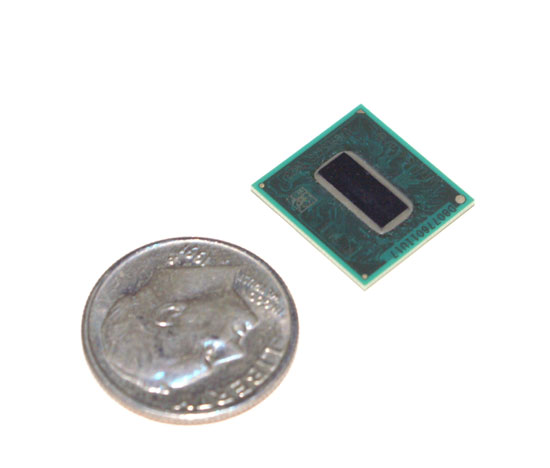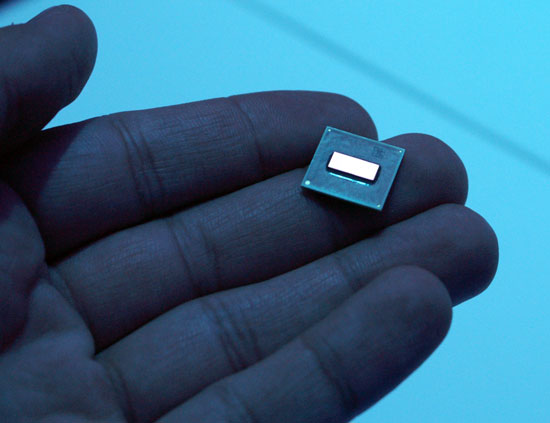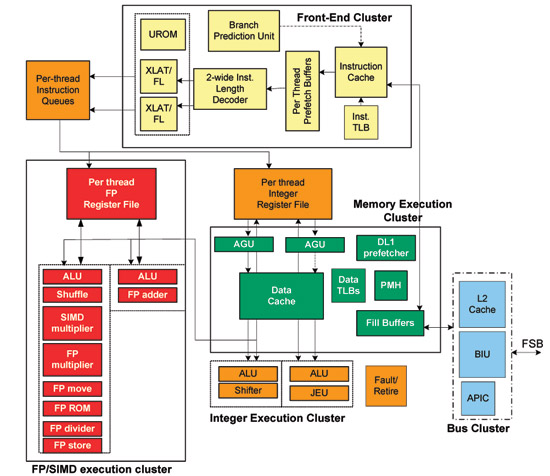Intel's Silverthorne Unveiled: Detailing Baby Centrino
by Anand Lal Shimpi on February 20, 2008 12:00 AM EST- Posted in
- CPUs
Who is Silverthorne?
In order to eventually compete in the ARM-space, Silverthorne has to be small and very cheap. The CPU itself is incredibly small thanks to its paltry 47M transistor count contributing to a die that's only 25 mm^2. Intel kept Silverthorne's die size small by greatly simplifying its architecture.


Silverthorne features a 16-stage in-order pipeline, meaning that it can only execute instructions in actual program order. This is different from Core 2, which can dynamically rearrange instructions in order to extract maximum parallelism from the code being worked on. By going with an in-order core, Intel reduces the complexity of the chip's design as well as reducing thermal output. Intel must balance the lack of instruction level parallelism that Silverthorne can extract with clever hardware and software tricks.

Remember Hyper Threading? Silverthorne will be the first Intel CPU since the Pentium 4 to allow the execution of two simultaneous threads on a single core. Silverthorne itself is too power hungry to be used in a dual-core design, and enabling two threads of execution yields a very efficient performance boost.
Since the CPU itself can't reorder instructions to help fill all available execution units, by allowing another thread of instructions to be dispatched simultaneously Intel increases the chances of fully utilizing all of Silverthorne's execution resources. Intel also trimmed the number of individual execution units on Silverthorne: SIMD and scalar integer multiplies are handled by the same unit, as are FP and integer divides.
Silverthorne can only issue two instructions per cycle, with the average IPC for most x86 applications at around 1 instruction the two thread design makes a lot of sense. Thankfully Silverthorne is being released into a world that is far more multithreaded than it was just a few years ago, otherwise such a design would hardly be sensible.
The 2-issue in-order design lessens the likelihood of being able to fill tons of execution units - so combining many functions into a single unit makes the most sense.
On the software side, Intel does do a lot in the compiler world which can come in handy, especially with Silverthorne. In-order processors shift the complexity of scheduling from the CPU to the compiler, meaning that while Silverthorne can run all x86 binaries, applications should be compiled for it in order to attain optimal performance.
| Intel Core 2 (Penryn) | Pentium M (Dothan) | Silverthorne | |
| L1 I-Cache | 32KB | 32KB | 32KB |
| L1 D-Cache | 32KB | 32KB | 24KB |
| L2 Cache | 6MB 24-way | 2MB 8-way | 512KB 8-way |
| Pipeline Length | 14 | 12 stages | 16 stages |
| x86 Decoding | 1 complex + 3 simple | 1 complex + 2 simple | 1 complex + 2 simple |
| Maximum decode rate | 4+1 | 3 | 2 |
| Issue ports | 6 | 5 | 4 |
| FP Units | 1 FMUL and 1 FADD 1 FSTORE and 1 FLOAD | 1 FMUL or FADD | 1 FADD and 1 FMUL/SSE |
| SSE Units | 3 | 1 | 1 |
| Integer Units | 3 | 2 | 2 |
| Manufacturing Process | 45nm | 90nm | 45nm |
| Die Size | 107 mm^2 | 84 mm^2 | 25 mm^2 |
| Transistor Count | 410M | 170M | 47M |
| Release Date | 2H 2007 | 2H 2004 | 1H 2008 |
Silverthorne in many ways is similarly equipped to the old 90nm Pentium, but still falls short overall - performance shouldn't be better, but at least within the realm of competitive










12 Comments
View All Comments
HelpfulVisitor - Wednesday, February 20, 2008 - link
Anand wrote the following:"The at 2.0GHz, running at 1.0V, Silverthorne runs at 90C and dissipates 2W. The CPU temperature alone should be indication that this is too hot for an ultra small iPhone-like form factor"
When the specs state TDP power at a given temperature, they are not claiming that the chip will dissipate that high of a temperature. They are baselining the TDP measurement, because leakage varies over different temperatures, and TDP needs to account for worst case conditions. It is standard practice to use the max Tcase temperature as a baseline, which is the temperature that the chip cannot exceed without permanent damage. Most chips operate WELL BELOW this.
While I cannot argue that Silverthorne would be inappropriate for iPhone, it is not because of the 90c degree specification. The 90c degree measurement only refers to where the thermal contraint specification has been measured.
stockascnc - Thursday, September 30, 2021 - link
NCFM Academy Hyderabad is one of the maximum properly know institutes now not simplest in Ameerpet but also in Hyderabad. <a href="https://www.ascncfmacademy.com/">Stock Market Training Institute in Hyderabad</a> We additionally offer Advanced Technical analysis training both on line and offline. We have designed the courses with years of experience and those publications will assure you success for sure. Just be part of the NCFM Academy Hyderabad if you need to research Advanced Technical Analysis. You can also study this course in Telugu too.Torched - Wednesday, February 20, 2008 - link
Going for the GeodeLX's jugular.puffpio - Wednesday, February 20, 2008 - link
Maybe Microsoft's answer to PSP and DS will use this hcipViRGE - Thursday, February 21, 2008 - link
I don't think so, the chip uses too much power. To give you an idea of the DS's power consumption, it comes with a 3.7v 1000mAh battery (in other words, 3.7watt-hours). Given that the DS lasts over 10 hours, you're looking at an average power consumption of 370mW for the entire device, meanwhile Silverthorne (just the CPU) is around 600mW before any other chips are added. The PSP/DS have the same power/thermal envelope as the iPhone, so you can count Silverthorne out of any similar device.Visual - Wednesday, February 20, 2008 - link
this just doesn't make sense... if it uses (and dissipates) less power than the scaled-down core cpus that are already in UMPCs, why would it's temperature be higher? why would it be harder to cool? why would it not be feasible for UMPCs?less is less, no matter how i look at it. i don't understand...
Visual - Wednesday, February 20, 2008 - link
oops, yeah. you said it wont be feasible for an iphone, not umpc.sorry i got confused... i guess it is just because i cant visualize the difference, not having seen either in person.
michael2k - Wednesday, February 20, 2008 - link
UMPC is about twice as big as an iPhone.UMPC is about half the size of an ultraportable laptop.
Calin - Wednesday, February 20, 2008 - link
"Inevitably the comparison to VIA's recently announced Isaiah CPU will be made, but Silverthorne is really aimed at a different market. Isaiah is a higher performance out-of-order core, while Silverthorne is eventually designed to make its way into highly integrated CE devices. We expect VIA's latest creation to outperform Silverthorne"I've never believed I'd live to see that - VIA outperforming Intel.
True, they might be targeting different power envelopes, but certainly Intel used to run circles around its competition from VIA
marsbound2024 - Wednesday, February 20, 2008 - link
On the "Who is Silverthorne" page, you repeated a paragraph talking about the sensibility of executing two IPC. Just wanted to throw that out there. :)